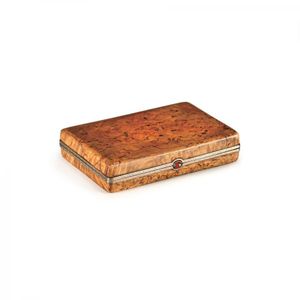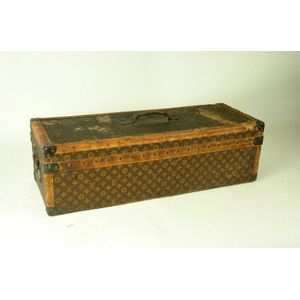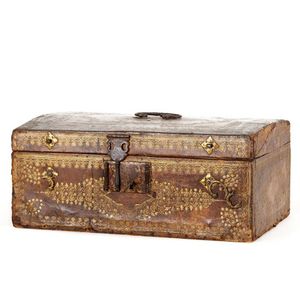17th Century French Tooled Leather Document Box
You must be a subscriber, and be logged in to view price and dealer details.
Subscribe Now to view actual auction price for this item
When you subscribe, you have the option of setting the currency in which to display prices to $Au, $US, $NZ or Stg.
- Oak - Native to Europe and England, oak has been used for joinery, furniture and building since the beginning of the medieval civilisation. It is a pale yellow in colour when freshly cut and darkens with age to a mid brown colour.
Oak as a furniture timber was superceded by walnut in the 17th century, and in the 18th century by mahogany,
Semi-fossilised bog oak is black in colour, and is found in peat bogs where the trees have fallen and been preserved from decay by the bog. It is used for jewellery and small carved trinkets.
Pollard oak is taken from an oak that has been regularly pollarded, that is the upper branches have been removed at the top of the trunk, result that new branches would appear, and over time the top would become ball-like. . When harvested and sawn, the timber displays a continuous surface of knotty circles. The timber was scarce and expensive and was used in more expensive pieces of furniture in the Regency and Victorian periods. - Embossed / Repousse - Embossing, also known as repousse, is the technique of decorating metal with raised designs, by pressing or beating out the design from the reverse side of the object.It is the opposite of chasing, where the decoration is applied from the front. An embossed or repoussed object may have chasing applied to finish off the design.
- Damask - Damask is a type of fabric that is characterized by its glossy finish, smooth texture, and intricate designs. The fabric is typically made from a combination of silk and other natural fibers, such as cotton or linen, and is often used to make clothing, upholstery, and other decorative items.
The origins of damask fabric can be traced back to ancient Rome and the Byzantine Empire, where it was used to make clothing and other textiles.
The fabric is made by weaving the fabric in such a way that the design is created by the different reflectivity of the warp and weft threads, rather than by the use of dyed threads. The designs are often floral or geometric patterns and can be very intricate. The effect is a reversible fabric, with a glossy pattern on one side and a matte pattern on the other. - Louis Xiv - Louis XIV (1638 ? 1715), known as Louis the Great or the Sun King, ruled through Cardinal Mazarin as chief minister from 1643 to 1661 and as monarch of the House of Bourbon and King of France and Navarre from 1661 until his death in 1715. His reign of 72 years is one of the longest in French and European history.
- Gold Tooled - Gold tooling on leather inlays in desks and other furniture and leather book bindings refers to the decorative process of embossing the leather with a design using gold leaf. The design is first traced onto the leather and then incised into the surface using a small blade. The incisions are then gilded with thin sheets of gold leaf. The gold leaf is burnished into the leather to create a raised, metallic design. The process is repeated until the entire design is covered in gold.
- Foliate - Decorated with leaves or leaf-like forms.
This item has been included into following indexes:
- boxes, function
- boxes, material or decoration - boxes, oak 84
Visually similar items

A Faberge cigarette case in Karelian birch mounted in silver-gilt with a cabochon ruby Thumbpiece, Workmaster Victor Aarne (1863-1934), St Petersburg hallmark for 1899-1908, Faberge cigarette cases are among the most attractive of the objects produced by t

An Art Nouveau coloured timber glove box, circa 1900, a sycamore lined box, probably cherrywood, of typical long hinged form, the top with floral decoration emulating pyrography with black outlines and pale foliage with tinted pink flowers, with key, heigh

A rare 1920s Louis Vuitton custom trunk made specifically for Encyclopaedia Britannica, the monogram canvas showing some distress, original leather trim and brass hardware including substantial end lockable latches, stitched leather top handle, the interio

An antique Swiss leather bound vestments trunk, rectangular shape with hinged domed cover, with steel bale handles to either end and decorated with steel decorative nails. Worked with nails to the front with the initials M.D. and dated 1796. 101 cm x 38 cm
